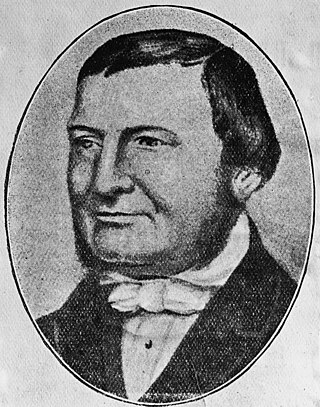
Wilhelm Sihler was a German American Lutheran minister. A proponent for Christian education, Wilhelm Sihler founded Concordia Theological Seminary, in Fort Wayne, Indiana.

Gotthard Daniel Fritzsche was a Prussian-Australian pastor who became instrumental in furthering that religion in South Australia. He was born in Liebenwerda, in the Electorate of Saxony, Germany, and migrated to Australia in 1841. From 1842 to 1863, he was pastor of the Evangelical Lutheran Church. He died and was buried at Lobethal, South Australia.

August Ludwig Christian Kavel was a founder of Lutheranism in Australia.
The history of theLutheran Church of Australia is the sequence of events related to divisions, mergers and affiliations of Lutheran church organisations from the time Lutheranism first arrived in Australia, to the time of unification of the two main synods in 1966.
The Evangelical Church Berlin-Brandenburg-Silesian Upper Lusatia is a United Protestant church body in the German states of Brandenburg, Berlin and a part of Saxony.
Old Lutherans were originally German Lutherans in the Kingdom of Prussia, notably in the Province of Silesia, who refused to join the Prussian Union of churches in the 1830s and 1840s. Prussia's king Frederick William III was determined to unify the Protestant churches, homogenize their liturgy, organization and even their architecture. In a series of proclamations over several years the Church of the Prussian Union was formed, bringing together the majority group of Lutherans, and the minority of Reformed. The main effect was that the government of Prussia had full control over church affairs, with the king recognized as the leading bishop.

Helmuth Brückner was Gauleiter of the National Socialist German Workers Party (NSDAP) in Silesia from 1925 until 1934, when he fell out of political favor.

Bartholomeus Strobel the Younger or Bartholomäus in German or Bartlomiej in Polish was a Baroque painter from Silesia, who worked in Prague, Silesia, and finally Poland, where he emigrated to escape the disruption of the Thirty Years War.

The Treaty or Convention of Altranstädt was signed between Charles XII of Sweden and Joseph I, Holy Roman Emperor on 31 August 1707. It settled the rights of Protestants in Silesia.
Dr. Alexandra Maria Catharina von Dyhrn was a German genealogist, author and the first woman in the province of Silesia to earn a doctorate.
Schlesische Arbeiter-Zeitung was a left-wing German language newspaper published from Breslau, Province of Lower Silesia, Weimar Germany between 1919 and 1933.
Heinrich Scholz was a German entomologist who specialised in Hemiptera and Diptera.

Karl Gotthelf Jakob Weinhold was a German folklorist and linguist who specialized in German studies.
David Erdmann was a German evangelical theologian and church historian.

Colmar Grünhagen was a German archivist and historian. Almost all of his considerable published output concerns the History of Silesia.

Arnold Schmitz was a German musicologist who was particularly concerned with Beethoven.
Karl Friedrich Wilhelm Wander was a German pedagogue and Germanist. He published the largest existing collection of German-language proverbs.
Josef Joachim Menzel was a German historian.
Ludwig Burgemeister was a German architect and monument preservationist.
Günther Grundmann was a German art historian, museum curator and monument preservator.













